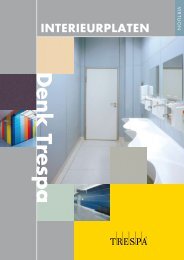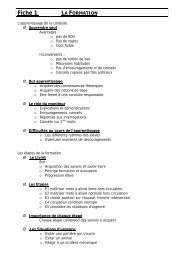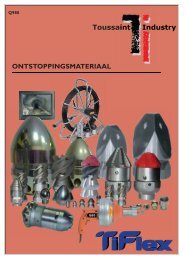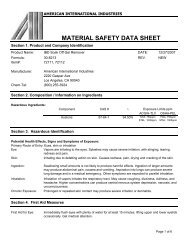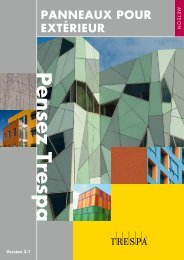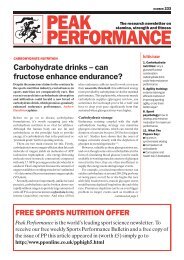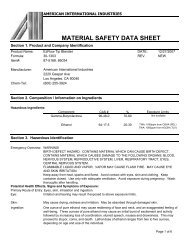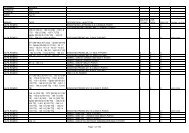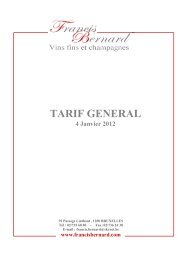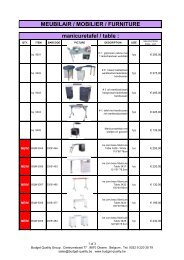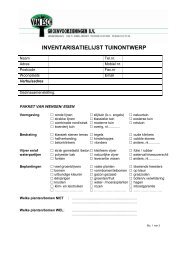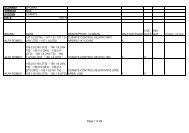30-1324 - EzFlow Q Monomer - Proximedia
30-1324 - EzFlow Q Monomer - Proximedia
30-1324 - EzFlow Q Monomer - Proximedia
Create successful ePaper yourself
Turn your PDF publications into a flip-book with our unique Google optimized e-Paper software.
AMERICAN INTERNATIONAL INDUSTRIES<br />
Section 1. Product and Company Identification<br />
Product Name: <strong>EzFlow</strong> Q <strong>Monomer</strong> DATE: 6/12/2007<br />
Formula: <strong>30</strong>-<strong>1324</strong><br />
REV. 01<br />
Item#:<br />
66068, 66069, 66070, 66071<br />
Manufacturer: American International Industries<br />
2220 Gaspar Ave<br />
Los Angeles, CA 90040<br />
Chem-Tel: (800) 255-3924<br />
Section 2. Composition / Information on Ingredients<br />
Hazardous Ingredients:<br />
N/E - None Established<br />
N/DA - No Data Available<br />
N/A - Not Applicable<br />
Section 3. Hazardous Identification<br />
Flammable liquid and vapor!<br />
MATERIAL SAFETY DATA SHEET<br />
Component<br />
Ethyl Methacrylate<br />
Glycol HEMA-Methacrylate<br />
HEMA<br />
Benzophenone<br />
Dimethyltolylamine<br />
Violet 2 (CI 60725)<br />
CAS # %<br />
97-63-2 >70<br />
97-90-5
Ingestion:<br />
Inhalation:<br />
Sub-Chronic Effects:<br />
Section 4. First Aid Measures<br />
First Aid for Eye:<br />
First Aid for Skin:<br />
First Aid for Inhalation:<br />
First Aid for Ingestion:<br />
Section 5. Fire Fighting Measures<br />
Flash Point (°F/°C): 68°F/20°C<br />
Flammable Limit<br />
(vol%):<br />
Auto-ignition Temp.<br />
(vol%)<br />
Extinguisher Media:<br />
Fire Fighting<br />
Instructions:<br />
Unusual Hazards:<br />
AMERICAN INTERNATIONAL INDUSTRIES<br />
LEL: 2% ; UEL: 2.5%<br />
392.8°C<br />
MATERIAL SAFETY DATA SHEET<br />
Causes irritation, a burning sensation of the mouth, throat and respiratory tract and abdominal<br />
pain.<br />
High vapor concentration may irritate the respiratory system. Prolonged exposure can lead to<br />
headaches, nausea, drowsiness and unconsciousness.<br />
Unlikely to cause a cancer hazard in man.<br />
Immediately flush with water for at least 15 minutes, including under eyelids. Seek medical<br />
attention if discomfort persists.<br />
Wash thoroughly with soap and water. Remove contaminated clothing and wash before reuse.<br />
Seek medical attention if discomfort persist.<br />
If large amounts are inhaled, remove to fresh air. If not breathing, give artificial respiration. If<br />
breathing is difficult, give oxygen, and call a physician.<br />
Rinse mouth out with water. Only induce vomiting if directed by physician. Never give anything<br />
by mouth to an unconscious person. Seek prompt medical attention.<br />
Foam, Carbon Dioxide, Dry Chemical or Carbon Tetrachloride<br />
Wear self-contained breathing apparatus and full protective gear. Water may be ineffective<br />
unless used as a fine spray or fog. Use water spray to cool the exposed containers of<br />
methacrylate monomer.<br />
Vapors may travel to source of ignition and flash back. Avoid ignition sources or excessive<br />
temperatures. Heat can induce polymerization with rapid release of energy. Closed containers<br />
may rupture explosively. Spontaneous polymerization may occur with prolonged aging.<br />
Section 6. Accidental Release Measures<br />
Page 2 of 7
Spill or Release<br />
Procedures:<br />
Section 7. Handling and Storage<br />
Handling:<br />
Storage:<br />
Explosion Hazard:<br />
Engineering Controls:<br />
General:<br />
Eye Protection:<br />
Skin Protection:<br />
AMERICAN INTERNATIONAL INDUSTRIES<br />
MATERIAL SAFETY DATA SHEET<br />
Eliminate all sources of heat and ignition. Use absorbent material for spills and dike it, wash spill<br />
material into retaining containers. Place containers in a well ventilated area. Consult an expert on<br />
disposal regulations. Keep unnecessary and unprotected personal from entering. Contain and recover<br />
liquid when possible . Use non-sparking tools and equipment. Collect liquid in an appropriate container.<br />
do not use combustible materials such as sawdust. Do not flush to sewer! US Regulations (CERCLA)<br />
require reporting spills and releases to soil, water and air in excess of reportable quantities. the toll free<br />
number for the US Coast Guard National Response Center is (800) 424-8802. If a leak or spill has not<br />
ignited, use water spray to disperse the vapors, to protect personnel attempting to stop leak, and flush<br />
spills away from exposures.<br />
Keep away from heat, sparks, flames and other sources of ignition. Avoid contact with eyes,<br />
skin and clothing. Avoid breathing vapor or mist. Use adequate ventilation. Ground all metal<br />
containers when transferring and use explosion-proof equipment. Follow all MSDS/label<br />
precautions even after the container is emptied because it may retain product residues. Wash<br />
skin thoroughly after handling.<br />
Store in a cool, dry area. Keep container closed when not in use. Store in ambient temperatures<br />
out of direct sunlight. Store in a well ventilated place. Store in accordance with National Fire<br />
Protection Association recommendations. Maintain air space inside storage containers. Inhibitor<br />
requires air (oxygen) contact to function. Check inhibitor levels after 3 months and return to<br />
original level.<br />
Avoid ignition sources or excessive temperatures. Heat can induce polymerization with rapid<br />
release of energy. Closed containers may rupture explosively. Spontaneous polymerization may<br />
occur with prolonged aging.<br />
Section 8. Exposure Controls / Personal Protective Equipment<br />
Use process enclosures, local exhaust ventilation, or other engineering controls to control<br />
airborne levels below recommended exposure limits. Use explosion-proof ventilation equipment.<br />
To identify additional Personal Protective Equipment (PPE) requirements, it is recommended<br />
that a hazard assessment in accordance with the OSHA PPE Standard (29CFR1910.132) be<br />
conducted before using this product. Provide eye wash stations and safety showers. wear<br />
impervious clothing to prevent ANY contact with this product, such as gloves, apron, boots, or<br />
whole body suit. Nitrile rubber is better than PVC<br />
Wear safety glasses. Wear coverall chemical splash goggles and face shield when the<br />
possibility exists for eye and face contact due to splashing or spraying of material.<br />
Wear impervious protective clothing, including boots, gloves, lab coat, apron or coveralls, as<br />
appropriate, to prevent skin contact. Neoprene and Nitrile rubber is better than PVC<br />
Page 3 of 7
Personal Respirators<br />
(NIOSH Approved):<br />
AMERICAN INTERNATIONAL INDUSTRIES<br />
Section 9. Physical and Chemical Properties<br />
MATERIAL SAFETY DATA SHEET<br />
Appearance @ 25°C: Blue-violet liquid Viscosity (RVT):
Mutagenicity: No data available<br />
Section 12. Ecological Information<br />
Chemical Fate Information:<br />
AMERICAN INTERNATIONAL INDUSTRIES<br />
MATERIAL SAFETY DATA SHEET<br />
Biodegradability: No data available<br />
Chemical Oxygen Demand: No data available<br />
Section 13. Disposable Considerations<br />
Dispose of diking materials and absorbent in compliance with State, Local, and Federal regulations. Residual vapors<br />
may explode on ignition; do not cut, drill or weld on or near the container. mix with compliance chemical which is less<br />
flammable and incinerate. Whatever cannot be saved for recovery or recycling should be handled as hazardous waste<br />
and sent to a RCRA approved incinerator or disposed in a RCRA approved waste facility. Processing, use or<br />
contamination of this product may change the waste management options. State and local disposal regulations may<br />
differ from federal disposal regulations. Dispose of container and unused contents in accordance with federal, state and<br />
local requirements.<br />
Section 14. Transportation Information<br />
(49 CFR 172)<br />
Proper Shipping Name:<br />
Flammable liquids, n.o.s., (ethyl methacrylate, ethylene glycol<br />
dimethacrylate), 3, UN1993, PGII<br />
Identification Number: UN1993<br />
Marine Pollutant: no<br />
Special Provisions: T8 , T31<br />
Emergency Response Guidebook (ERG) # :<br />
IATA (DGR) :<br />
128<br />
Proper Shipping Name:<br />
Flammable liquids, n.o.s., (ethyl methacrylate, ethylene glycol<br />
dimethacrylate), 3, UN1993, PGII<br />
Class or Division: 3<br />
UN or ID Number:<br />
Packaging Instructions:<br />
UN1993<br />
Emergency Response Guidebook (ERG) # :<br />
IMO (IMDG) :<br />
Proper Shipping Name:<br />
Flammable liquids, n.o.s., (ethyl methacrylate, ethylene glycol<br />
dimethacrylate), 3, UN1993, PGII<br />
Class or Division: 3.2<br />
UN or ID Number: Un1993<br />
Special Provisions & Stowage/Segregation: None<br />
Page 5 of 7
Section 15. Regulatory Information<br />
AMERICAN INTERNATIONAL INDUSTRIES<br />
MATERIAL SAFETY DATA SHEET<br />
Federal Regulatory Status:<br />
Resource Conservation & Recover Act (RCRA) Classification:<br />
Ethyl methacrylate, CAS# 97-63-2, RCRA Code: U118<br />
Characteristic of Ignitability, RCRA Code:D001<br />
FDA: This product has not been approved by the FDA for use in food packaging and/or other<br />
applications as an indirect food additive.<br />
Clean Water Act: Priority Pollutant: None<br />
State Regulatory Status:<br />
Clean Air Act: HAP/ODS: This product contains the following hazardous air pollutants (HAP)<br />
and ODS's as defined by the U.S Clean Air Act; Benzophenone CAS # 119-61-9 (HAP) This<br />
product does not contain any Class 1 or Class 2 ODS<br />
Occupational Safety and Health Act: This Product is considered to be a hazardous chemical<br />
under the OSHA Hazard Communication Standard. Its hazards are: Immediate (acute) health<br />
hazard. Fire Hazard<br />
SARA Title III: Section <strong>30</strong>2 (TPQ): None<br />
SARA Title III: Section <strong>30</strong>2 (RQ): This product contains chemicals regulated under section <strong>30</strong>4<br />
as extremely hazardous chemicals for emergency release notification ("CERCLA" List).<br />
Ethyl methacrylate, CAS# 97-63-2, RQ (Lbs): 1000<br />
Superfund Amendment & Reauthorization Act (SARA) Title III:<br />
SARA Hazard Categories (311/312): Fire Hazard. Immediate (Acute) Health Hazard.<br />
SARA Toxic Release Inventory (TRI) (313): None<br />
The following chemical are specifically listed by individual states; other product specific health<br />
and safety data in other sections of the MSDS may also be applicable for state requirements.<br />
For details on your regulatory requirements you should contact the appropriate agency in your<br />
state.<br />
MA Right-to-Know Law:<br />
Ethyl methacrylate, CAS# 97-63-2<br />
NJ Right-to Know Law:<br />
Ethyl methacrylate, CAS# 97-63-2<br />
PA Right-to-Know:<br />
Ethyl methacrylate, CAS# 97-63-2<br />
FL Right-to-Know:<br />
Ethyl methacrylate, CAS# 97-63-2<br />
MN Right-to-Know:<br />
Benzophenone CAS # 119-61-9<br />
International Regulations:<br />
CDSL: Canadian Inventory (on Canadian Transitional List)<br />
Page 6 of 7
Section 16. Other Information<br />
HMIS:<br />
Health=2<br />
Flammability=3<br />
Reactivity=1<br />
AMERICAN INTERNATIONAL INDUSTRIES<br />
MATERIAL SAFETY DATA SHEET<br />
N, N-dimthyl-p-toluidine: DSL regulatory status: Included, WHMIS: none<br />
2-hydroxyethyl methacrylate: DSL regulatory status: Included, WHMIS: D2A<br />
Ethylene glycol dimethacrylate esters: DSL regulatory status: Included, WHMIS: D2B<br />
Benzphenone: DSL regulatory status: Included<br />
EINECS: European Inventory<br />
<strong>EzFlow</strong> Q <strong>Monomer</strong>:<br />
HAZARD SYMBOLS: Xi, F: Irritant, Highly Flammable<br />
RISK PHRASES: R11: highly flammable, R36/37/38: Irritating to eyes, respiratory system and<br />
skin, R43: May cause sensitization by skin contact<br />
SAFETY PHRASES: S9: keep container in a well ventilated place, S16: keep away from<br />
sources of ignition- no smoking, S29: do not empty into drains, S33: take precautionary<br />
measures against static discharges, S36/37/39: wear suitable protective clothing, gloves and<br />
eye/face protection, S45: in case of accident or if you feel unwell, seek medical advise<br />
immediately (show the label where possible)<br />
Page 7 of 7



